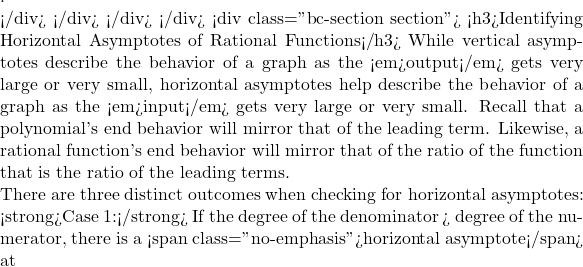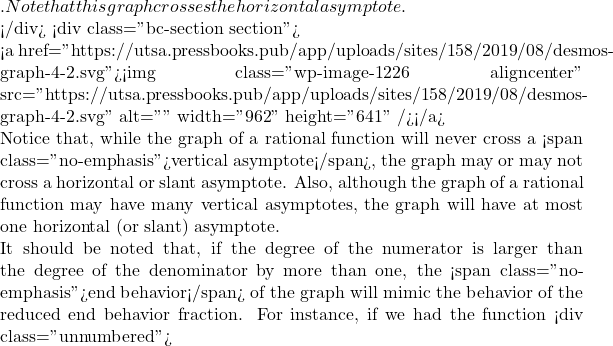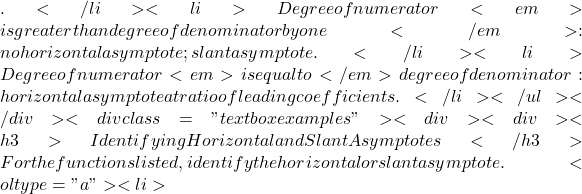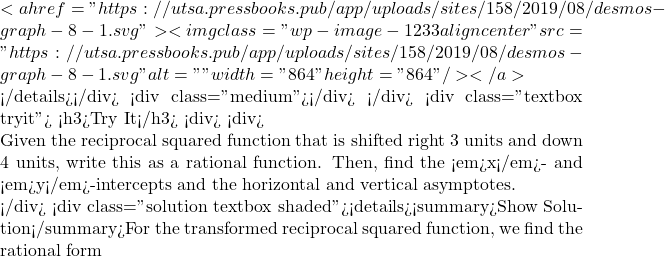Learning Module 07B Rational Functions & Graphs
Analyzing Rational Functions
Learning Objectives
In this section, you will:
- Use arrow notation.
- Solve applied problems involving rational functions.
- Find the domains of rational functions.
- Identify vertical asymptotes.
- Identify horizontal asymptotes.
- Identify
 intercept(s) for rational functions.
intercept(s) for rational functions. - Identify
 intercept for rational functions.
intercept for rational functions.
Suppose we know that the cost of making a product is dependent on the number of items ![]() produced. This is given by the equation
produced. This is given by the equation ![]() .If we want to know the average cost for producing
.If we want to know the average cost for producing ![]() items, we would divide the cost function by the number of items
items, we would divide the cost function by the number of items ![]() .
.
The average cost function, which yields the average cost per item for ![]() items produced, is
items produced, is
Many other application problems require finding an average value in a similar way, giving us variables in the denominator. Written without a variable in the denominator, this function will contain a negative integer power.
In the last few sections, we have worked with polynomial functions, which are functions with non-negative integers for exponents. In this section, we explore rational functions, which have variables in the denominator.
Using Arrow Notation
We have seen the graphs of the basic reciprocal function and the squared reciprocal function from our study of toolkit functions. Examine these toolkit function graphs and notice some of their features.
Several things are apparent if we examine the graph of ![]() .
.
- On the left branch of the graph, the curve approaches the x-axis
 .
. - As the graph approaches
 from the left, the curve drops, but as we approach zero from the right, the curve rises.
from the left, the curve drops, but as we approach zero from the right, the curve rises. - Finally, on the right branch of the graph, the curves approaches the x-axis
 .
.
To summarize, we use arrow notation to show that ![]() or
or ![]() is approaching a particular value.
is approaching a particular value.
| Symbol | Meaning |
|---|---|
| the output approaches infinity (the output increases without bound) | |
| the output approaches negative infinity (the output decreases without bound) | |
| the output approaches |
Local Behavior of 
Let’s begin by looking at the reciprocal function ![]() .We cannot divide by zero, which means the function is undefined at
.We cannot divide by zero, which means the function is undefined at ![]() so zero is not in the domain. As the input values approach zero from the left side (becoming very small, negative values), the function values decrease without bound (in other words, they approach negative infinity). We can see this behavior in the table below. This is a similar concept to vertical asymptotes for logarithmic functions. The difference for the reciprocal function,
so zero is not in the domain. As the input values approach zero from the left side (becoming very small, negative values), the function values decrease without bound (in other words, they approach negative infinity). We can see this behavior in the table below. This is a similar concept to vertical asymptotes for logarithmic functions. The difference for the reciprocal function, ![]() , is that the graph behavior around the asymptotes is opposite. We use specific left and and right hand arrow notation to denote this change in behavior.
, is that the graph behavior around the asymptotes is opposite. We use specific left and and right hand arrow notation to denote this change in behavior.
| |
–0.1 | –0.01 | –0.001 | –0.0001 |
| |
–10 | –100 | –1000 | –10,000 |
We write in arrow notation as ![]() ,
, ![]() . Notice when the
. Notice when the ![]() values are approaching zero from the left, or values that are smaller than 0, we use the notation
values are approaching zero from the left, or values that are smaller than 0, we use the notation ![]() .
.
As the input values approach zero from the right side (becoming very small, positive values), the function values increase without bound (approaching infinity). We can see this behavior in the table below.
| |
0.1 | 0.01 | 0.001 | 0.0001 |
| |
10 | 100 | 1000 | 10,000 |
We write in arrow notation as ![]() . Notice when the
. Notice when the ![]() values are approaching zero from the right, or values that are larger than 0, we use the notation
values are approaching zero from the right, or values that are larger than 0, we use the notation ![]() .
.
This behavior creates a vertical asymptote, which is a vertical line that the graph approaches but never crosses. In this case, the graph is approaching the vertical line ![]() as the input becomes close to zero.
as the input becomes close to zero.
Vertical Asymptote
A vertical asymptote of a graph is a vertical line ![]() where the graph tends toward positive or negative infinity as the inputs approach
where the graph tends toward positive or negative infinity as the inputs approach ![]() .We write
.We write
End Behavior of 
As the values of ![]() approach infinity, the function values approach 0. As the values of
approach infinity, the function values approach 0. As the values of ![]() approach negative infinity, the function values approach 0. Symbolically, using arrow notation.
approach negative infinity, the function values approach 0. Symbolically, using arrow notation.
As ![]()
![]() and as
and as ![]()
![]() .
.
Based on this overall behavior and the graph, we can see that the function approaches 0 but never actually reaches 0; it seems to level off as the inputs become large. This behavior creates a horizontal asymptote, a horizontal line that the graph approaches as the input increases or decreases without bound. In this case, the graph is approaching the horizontal line ![]() This is a similar concept to horizontal asymptotes for exponential functions.
This is a similar concept to horizontal asymptotes for exponential functions.
Horizontal Asymptote
A horizontal asymptote of a graph is a horizontal line ![]() where the graph approaches the line as the inputs increase or decrease without bound. We write
where the graph approaches the line as the inputs increase or decrease without bound. We write
Using Arrow Notation
Use arrow notation to describe the end behavior and local behavior of the function graphed below.
Show Solution
Notice that the graph is showing a vertical asymptote at ![]() which tells us that the function is undefined at
which tells us that the function is undefined at ![]() .
.
And as the inputs decrease without bound, the graph appears to be leveling off at output values of 4, indicating a horizontal asymptote at ![]() .As the inputs increase without bound, the graph levels off at 4.
.As the inputs increase without bound, the graph levels off at 4.
Try It
Use arrow notation to describe the end behavior and local behavior for the reciprocal squared function.
Show Solution
End behavior: as ![]() Local behavior: as
Local behavior: as ![]() (there are no x– or y-intercepts)
(there are no x– or y-intercepts)
Solving Applied Problems Involving Rational Functions
A rational function is a function that can be written as the quotient of two polynomial functions. Many real-world problems require us to find the ratio of two polynomial functions. Problems involving rates and concentrations often involve rational functions.
Rational Function
A rational function is a function that can be written as the quotient of two polynomial functions ![]() .
.
Solving an Applied Problem Involving a Rational Function
A large mixing tank currently contains 100 gallons of water into which 5 pounds of sugar have been mixed. A tap will open pouring 10 gallons per minute of water into the tank at the same time sugar is poured into the tank at a rate of 1 pound per minute. Find the ratio of sugar to water, in pounds per gallon in the tank after 12 minutes. Is that a greater ratio of sugar to water, in pounds per gallon than at the beginning?
Show Solution
Let ![]() be the number of minutes since the tap opened. Since the water increases at 10 gallons per minute, and the sugar increases at 1 pound per minute, these are constant rates of change. This tells us the amount of water in the tank is changing linearly, as is the amount of sugar in the tank. We can write an equation independently for each:
be the number of minutes since the tap opened. Since the water increases at 10 gallons per minute, and the sugar increases at 1 pound per minute, these are constant rates of change. This tells us the amount of water in the tank is changing linearly, as is the amount of sugar in the tank. We can write an equation independently for each:
![]()
The ratio of sugar to water, in pounds per gallon ![]() will be the ratio of pounds of sugar to gallons of water
will be the ratio of pounds of sugar to gallons of water
![]()
The ratio of sugar to water, in pounds per gallon after 12 minutes is given by evaluating ![]() at
at ![]() .
.

This means the ratio of sugar to water, in pounds per gallon is 17 pounds of sugar to 220 gallons of water.
At the beginning, the ratio of sugar to water, in pounds per gallon is

Since ![]() the ratio of sugar to water, in pounds per gallon is greater after 12 minutes than at the beginning.
the ratio of sugar to water, in pounds per gallon is greater after 12 minutes than at the beginning.
Finding the Domains of Rational Functions
A vertical asymptote represents a value at which a rational function is undefined, so that value is not in the domain of the function. A reciprocal function cannot have values in its domain that cause the denominator to equal zero. In general, to find the domain of a rational function, we need to determine which inputs would cause division by zero.
Domain of a Rational Function
The domain of a rational function includes all real numbers except those that cause the denominator to equal zero.
How To
Given a rational function, find the domain.
- Set the denominator equal to zero.
- Solve to find the x-values that cause the denominator to equal zero.
- The domain is all real numbers except those found in Step 2.
Finding the Domain of a Rational Function
Find the domain of ![]() .
.
Show Solution
Begin by setting the denominator equal to zero and solving.

The denominator is equal to zero when ![]() .The domain of the function is all real numbers except
.The domain of the function is all real numbers except ![]() .
.
Try It
Find the domain of ![]() .
.
Show Solution
The domain is all real numbers except ![]() and
and ![]() .
.
Identifying Vertical Asymptotes of Rational Functions
By looking at the graph of a rational function, we can investigate its local behavior and easily see whether there are asymptotes. We may even be able to approximate their location. Even without the graph, however, we can still determine whether a given rational function has any asymptotes, and calculate their location.
Vertical Asymptotes
The vertical asymptotes of a rational function may be found by examining the factors of the denominator that are not common to the factors in the numerator. Vertical asymptotes occur at the zeros of such factors.
Given a rational function, identify any vertical asymptotes of its graph.
- Factor the numerator and denominator.
- Note any restrictions in the domain of the function.
- Reduce the expression by canceling common factors in the numerator and the denominator.
- Note any values that cause the denominator to be zero in this simplified version. These are where the vertical asymptotes occur.
- Note any restrictions in the domain where asymptotes do not occur. These are removable discontinuities, or “holes.”
Identifying Vertical Asymptotes
Find the vertical asymptotes of the graph of ![]() .
.
Show Solution
First, factor the numerator and denominator.

To find the vertical asymptotes, we determine where this function will be undefined by setting the denominator equal to zero:
![]()
Neither ![]() nor
nor ![]() are zeros of the numerator, so the two values indicate two vertical asymptotes. The graph confirms the location of the two vertical asymptotes.
are zeros of the numerator, so the two values indicate two vertical asymptotes. The graph confirms the location of the two vertical asymptotes.
Removable Discontinuities
Occasionally, a graph will contain a hole: a single point where the graph is not defined, indicated by an open circle. We call such a hole a removable discontinuity.
For example, the function
*** QuickLaTeX cannot compile formula:
f(x)= \dfrac{x^{2}-1}{x^{2} -2x-3
*** Error message:
File ended while scanning use of \@genfrac.
Emergency stop.
may be re-written by factoring the numerator and the denominator.
 x+1
x+1![]() x=-1
x=-1![]() x-3
x-3![]() x=3
x=3  x=a
x=a ![]() a
a  k(x) = \dfrac{x-2}{x^{2}-4}
k(x) = \dfrac{x-2}{x^{2}-4}
Show Solution
Factor the numerator and the denominator.
 x-2
x-2 ![]() x=2
x=2 ![]() x+2
x+2 ![]() x=-2
x=-2 ![]() x=-2
x=-2  y=0
y=0 ![]() f\left(x\right)=\dfrac{4x+2}{{x}^{2}+4x-5}
f\left(x\right)=\dfrac{4x+2}{{x}^{2}+4x-5} ![]() f\left(x\right) \approx \dfrac{4x}{{x}^{2}}=\dfrac{4}{x}
f\left(x\right) \approx \dfrac{4x}{{x}^{2}}=\dfrac{4}{x} ![]() g\left(x\right)=\dfrac{4}{x},
g\left(x\right)=\dfrac{4}{x}, ![]() y=0
y=0 ![]() y
y![]() x
x f\left(x\right)=\dfrac{3{x}^{2}-2x+1}{x-1}
f\left(x\right)=\dfrac{3{x}^{2}-2x+1}{x-1} ![]() f\left(x\right) \approx \dfrac{3{x}^{2}}{x}=3x
f\left(x\right) \approx \dfrac{3{x}^{2}}{x}=3x ![]() g\left(x\right)=3x
g\left(x\right)=3x ![]() g\left(x\right)=3x
g\left(x\right)=3x ![]() f
f ![]() g,
g, ![]() y=3x
y=3x ![]() \dfrac{3{x}^{2}-2x+1}{x-1}
\dfrac{3{x}^{2}-2x+1}{x-1} ![]() 3x+1,
3x+1, ![]() g\left(x\right)=3x+1
g\left(x\right)=3x+1  y=\dfrac{{a}_{n}}{{b}_{n}},
y=\dfrac{{a}_{n}}{{b}_{n}}, ![]() {a}_{n}
{a}_{n} ![]() {b}_{n}
{b}_{n} ![]() p\left(x\right)
p\left(x\right) ![]() q\left(x\right)
q\left(x\right) ![]() f\left(x\right)=\dfrac{p\left(x\right)}{q\left(x\right)},q\left(x\right)ne 0
f\left(x\right)=\dfrac{p\left(x\right)}{q\left(x\right)},q\left(x\right)ne 0 ![]() text{Example: }f\left(x\right)=\dfrac{3{x}^{2}+2}{{x}^{2}+4x-5}
text{Example: }f\left(x\right)=\dfrac{3{x}^{2}+2}{{x}^{2}+4x-5} ![]() f\left(x\right) \approx \dfrac{3{x}^{2}}{{x}^{2}}=3
f\left(x\right) \approx \dfrac{3{x}^{2}}{{x}^{2}}=3 ![]() g\left(x\right)=3,
g\left(x\right)=3, ![]() x \rightarrow ±\infty ,f\left(x\right) \rightarrow 3,
x \rightarrow ±\infty ,f\left(x\right) \rightarrow 3, ![]() y=3
y=3  f\left(x\right)=\dfrac{3{x}^{5}-{x}^{2}}{x+3}
f\left(x\right)=\dfrac{3{x}^{5}-{x}^{2}}{x+3} ![]() f\left(x\right)approx \dfrac{3{x}^{5}}{x}=3{x}^{4}
f\left(x\right)approx \dfrac{3{x}^{5}}{x}=3{x}^{4} ![]() x \rightarrow \pm \infty , f\left(x\right) \rightarrow \infty
x \rightarrow \pm \infty , f\left(x\right) \rightarrow \infty  y=0
y=0  g\left(x\right)=\dfrac{6{x}^{3}-10x}{2{x}^{3}+5{x}^{2}} \vspace{10pt}
g\left(x\right)=\dfrac{6{x}^{3}-10x}{2{x}^{3}+5{x}^{2}} \vspace{10pt}![]() h\left(x\right)=\dfrac{{x}^{2}-4x+1}{x+2} \vspace{10pt}
h\left(x\right)=\dfrac{{x}^{2}-4x+1}{x+2} \vspace{10pt}![]() k\left(x\right)=\dfrac{{x}^{2}+4x}{{x}^{3}-8}
k\left(x\right)=\dfrac{{x}^{2}+4x}{{x}^{3}-8}  f\left(x\right)=\dfrac{p\left(x\right)}{q\left(x\right)}, q\left(x\right)ne 0
f\left(x\right)=\dfrac{p\left(x\right)}{q\left(x\right)}, q\left(x\right)ne 0 ![]() g\left(x\right)=\dfrac{6{x}^{3}-10x}{2{x}^{3}+5{x}^{2}}:
g\left(x\right)=\dfrac{6{x}^{3}-10x}{2{x}^{3}+5{x}^{2}}: ![]() p=text{degree of} q=3,
p=text{degree of} q=3, ![]() y=\dfrac{6}{2}
y=\dfrac{6}{2} ![]() y=3
y=3 ![]() \vspace{10pt}
\vspace{10pt}![]() h\left(x\right)=\dfrac{{x}^{2}-4x+1}{x+2}:
h\left(x\right)=\dfrac{{x}^{2}-4x+1}{x+2}: ![]() p=2
p=2 ![]() q=1
q=1 ![]() p>q
p>q ![]() \dfrac{{x}^{2}-4x+1}{x+2}
\dfrac{{x}^{2}-4x+1}{x+2} ![]() x–6
x–6 ![]() y=x–6
y=x–6 ![]() \vspace{10pt}
\vspace{10pt}![]() k\left(x\right)=\dfrac{{x}^{2}+4x}{{x}^{3}-8}:
k\left(x\right)=\dfrac{{x}^{2}+4x}{{x}^{3}-8}: ![]() p=2
p=2 ![]() q=3,
q=3, ![]() y=0
y=0  C\left(t\right)=\dfrac{5+t}{100+10t}
C\left(t\right)=\dfrac{5+t}{100+10t}  t,
t, ![]() 10t,
10t, ![]() tto \infty , C\left(t\right)to \dfrac{1}{10}
tto \infty , C\left(t\right)to \dfrac{1}{10} ![]() y=\dfrac{1}{10}
y=\dfrac{1}{10} ![]() C
C ![]() \dfrac{1}{10}
\dfrac{1}{10} ![]() \dfrac{1}{10}
\dfrac{1}{10}  f\left(0\right)
f\left(0\right)  g\left(x\right)=\frac{\left(x-2\right)\left(x+3\right)}{\left(x+2\right)\left(x-5\right)}.
g\left(x\right)=\frac{\left(x-2\right)\left(x+3\right)}{\left(x+2\right)\left(x-5\right)}.

\vspace{10pt}

\vspace{10pt}![]() \left(0,–0.6\right),
\left(0,–0.6\right), ![]() \left(2,0\right)
\left(2,0\right) ![]() \left(–3,0\right)
\left(–3,0\right) ![]() \vspace{10pt}
\vspace{10pt} .f\left(x\right)=\dfrac{1}{{\left(x-3\right)}^{2}}-4=\dfrac{1-4{\left(x-3\right)}^{2}}{{\left(x-3\right)}^{2}}=\dfrac{1-4\left({x}^{2}-6x+9\right)}{\left(x-3\right)\left(x-3\right)}=\dfrac{-4{x}^{2}+24x-35}{{x}^{2}-6x+9}
.f\left(x\right)=\dfrac{1}{{\left(x-3\right)}^{2}}-4=\dfrac{1-4{\left(x-3\right)}^{2}}{{\left(x-3\right)}^{2}}=\dfrac{1-4\left({x}^{2}-6x+9\right)}{\left(x-3\right)\left(x-3\right)}=\dfrac{-4{x}^{2}+24x-35}{{x}^{2}-6x+9} ![]() x \rightarrow ±\infty , f\left(x\right) \rightarrow -4
x \rightarrow ±\infty , f\left(x\right) \rightarrow -4 ![]() y=–4
y=–4 ![]() x=3,
x=3, ![]() x \rightarrow 3
x \rightarrow 3 ![]() f\left(x\right) \rightarrow \infty
f\left(x\right) \rightarrow \infty ![]() \left(2.5,0\right)
\left(2.5,0\right) ![]() \left(3.5,0\right)
\left(3.5,0\right) ![]() \left(0,\dfrac{-35}{9}\right)
\left(0,\dfrac{-35}{9}\right)  f\left(x\right)=\dfrac{1}{x}
f\left(x\right)=\dfrac{1}{x} ![]() f\left(x\right)=\dfrac{1}{{x}^{2}}
f\left(x\right)=\dfrac{1}{{x}^{2}}  x={x}_{1},{x}_{2},dots ,{x}_{n},
x={x}_{1},{x}_{2},dots ,{x}_{n}, ![]() x={v}_{1},{v}_{2},dots ,{v}_{m},
x={v}_{1},{v}_{2},dots ,{v}_{m}, ![]() {x}_{i}=text{any }{v}_{j}, $ then the function can be written in the form
{x}_{i}=text{any }{v}_{j}, $ then the function can be written in the form
![]()

